• Pre-processing.
• Segmentation
• Recognition
• Comparison

International Journal of Scientific & Engineering Research, Volume 5, Issue 5, May-2014 853
ISSN 2229-5518
Number Plate Recognition using morphological operations
Ashwini Dama, Prof. Todmal S.R.
Key words — Vehicle number plate localization, morphological operation opening and closing, optical character recognition.
—————————— ——————————
The aim of this paper is to build application which recognises number plate at the entrance of a gate. By using camera, the system captures the number plate of a car and processes them. Once the number plate is detected, recognition is done with the help of database. The aim of the project is to avoid traffic issues and similar problems. The algorithm which is used in this project includes following steps:
• Pre-processing.
• Segmentation
• Recognition
• Comparison
The first stage of image processing for number plate is the im- age captured by Electronic devices such as optical (digi- tal/video) camera, webcam etc. For this project, vehicle imag- es will be taken with a digital camera. The images will be stored as colour JPEG format on the camera. The distance be- tween image and camera should be 5-6 meters. After that the captured image is converted into gray scale image.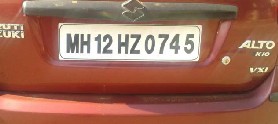
Fig. 2.Original image for recognition.
The RGB image is then converted into a gray scale image for easy analysis as it consists of only two colour channels. Medi- an filtering is used to remove salt and pepper noise. The aim of this process is to improve the picture quality of the image. Image enhancement techniques consists process of sharpening the edges of image, contrast manipulation, reducing noise, colour image processing and image segmentation as well. The gray image is then cropped whereby it will extract the smallest rectangle which will contain the edge of the license plate and license plate itself. This cropping process will highly increase the speed of image processing. The figure below shows the binarised image:
IJSER © 2014 http://www.ijser.org
International Journal of Scientific & Engineering Research, Volume 5, Issue 5, May-2014 854
ISSN 2229-5518
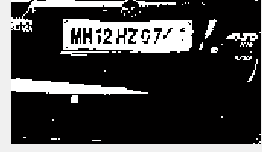
Fig. 3.The binarised image.
Our proposed method applies basic mathematical morpholo- gy operations like ‘opening’ and ‘closing’ alongwith very sim- ple heuristics for the localization of the license plates and character recognition technology to extract the numbers from the localized license plate. It is a topological and geometrical based approach for image analysis which provides powerful tools for extracting geometrica lstructures and representing shapes in many applications. In mathematical morphology these are represented as matrices. Structuring element is a characteristic of certain structure and features to measure the shape of an image and is used to carry out other image pro- cessing operations. The shape and size of the structuring gel- ement (SE) plays crucial role in image processing and is there- fore chosen according to the condition of the image and de- mand of processing.
Typical structuring elements are shown below:
. 
Fig. 4. Segmented number plate using morphological opening.![]()
Fig. 5. Segmented numbers
It is employed for the purpose of conversion of images of text into characters. The process of OC involves several steps in- cluding segmentation, feature extraction and classification. Each of these steps is a field onto itself and is described briefly here in the context of a Matlab implementation of Optical
Character Recognition (OCR).
Before recognition algorithm normalisation is done. Normali- zation provides a tremendous reduction in data size of the characters. For perfect match, input images must be equal- sized with the database characters. The extracted characters cut from plate and the characters on database are now equal- sized.
The next step is comparison. In this, character image is com- pared with the database and the best similarity is measured. To measure the similarity correlation is used. This method measures the correlation coefficient between a number of known images with the same size unknown images or parts of an image with the highest correlation coefficient between the images producing the best match.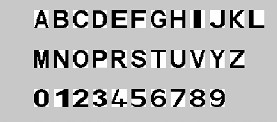
The output of OCR on the segmented license plate shown above is: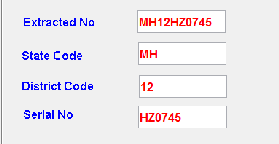
Fig. 6. The output of OCR on the segmented license Plate.
Database is a collection of information or data which it is be- ing orderly organized thus it can be accessed easily and up- dated. Database can be in the form of text, contents and imag- es. Database is needed to make sure that the image space can contain enough characters which have been extracted and the vehicle license plated number stored in the notepad for the purpose of comparison. The database would be enlarged in- order to improve the accuracy and better chances of obtaining the correct result. The class recognition will check if the com- puted ratio is correct. It will ignore the class if the image thresholding is too low. If the class has match correctly, it will be compare with data set in the database and provide an out- put if the image is recognized correctly. Characters are com- pared to determine whether the input image is authenticated
IJSER © 2014 http://www.ijser.org
International Journal of Scientific & Engineering Research, Volume 5, Issue 5, May-2014 855
ISSN 2229-5518
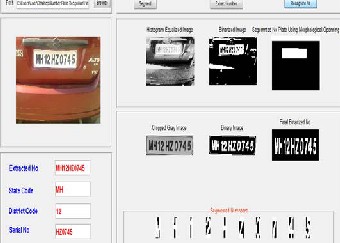
or not. This is done by comparing the recognised license plate with the database. The database contains the list of license plate which are authorised. Comparision is done line by line and by checking every character in each line. If all characters are matched then message will come as “authenticate”.
The system’s accuracy in locating the number plate is more than 98%. The problem encountered in the earlier systems in locating the number plate when vehicle bodies and their num- ber plates have similar colors was overcome. There by achiev- ing higher accuracy in number plate extraction step. As the fonts vary from one number plate to the other, ambiguous situation may arise in recognizing the characters ‘G’ and ’C’,
‘I’ and ‘1’, ‘7’ and ‘T’ and alike since OCR template was devel-
oped for one particular font. But some of them were overcome
by “character categorization” approach.
Table1. Results of the Test
Units of LPR Sys- tem | Number of Accura- cy | Percentage of Accura- cy |
Extraction of Plate Region | 15/15 | 100 |
Segmentation | 14/15 | 94 |
Recognition of Characters | 14/15 | 94 |
A morphology based approach for localization of Indian li- cense plates along with the number recognition based on tem- plate matching has been proposed. In this approach, number plate located at any corner of image can be recognized. Num- ber plates having variations in background as well as font can be easily localized. Unwanted conditions such as screws and unwanted text on number plate which create problem for lo- calization are treated suitably and taken into consideration. This logarithm has been found to be 90% accurate overall. The major sources of error were due tomisinterpretation of charac- ters in the number plate caused byextreme variation in the dimensions, overlapping and style of the characters and low contrast in images. However these errors can be aptly rectified by using more adaptive thresholding methods and advanced techniques such astrained Neural Networks.
Fig.7. Graphical User Interface for the Demo program
I would like to express my sincere gratitude towards my Pro- ject Guide Prof. Todmal S. R. for his constant support and guidance throughout the completion of this paper. I would not hesitate to thank my friends for constant help and Co- operation given to me.
[1] Ankush Roy, DebarshiPatanjaliGhoshal, “Number Plate Recognition for Use in Different Countries Using an Im- proved Segmentation”. 978-1-4244-9581-8/11/$26.00 ©
2011 IEEE.
[2] P. V. Suryanarayana, Suman K. Mitra, Asim Banerjee and Anil K.Roy “A Morphology Based Approach for car license Plate” IEEEIndicon 2005 Conference, Chennai, India, 11-13
Dec. 2005.
[3] P.ANISHIYA 1, PROF. S. MARY JOANS, ‘‘Number Plate Recognition for Indian Cars Using Morphological charac- ters”.2011 InternationalConference on Information and Network Technology IACSIT Press, Singapore 115IPCSIT vol.4 (2011) © (2011) IACSIT Press, Singapore.
[4] S.Kranthi, K.Pranathi, A.Srisaila, ‘‘Automatic Number
Plate Recognition”.International Journal of a dancements in Technology http://ijict.org/ ISSN 0976-4860.
[5] Wong Eng Yong, ‘‘Vehicle License Plate Registration
Recognition System”. Jul07.
[6] ‘‘Image Segmentation” .A.D. Jepson and D.J. Fleet, 2007. [7] ‘‘Digital Image Processing”. Written by R.C.Gonjaliz.2009. [8] Jui-Chen Wu · Jun-Wei Hsieh · Yung-Sheng Chen. Mor-
phology Based text line Extraction” MachineVision and
Applications, pp.195–207, 2008.
IJSER © 2014 http://www.ijser.org